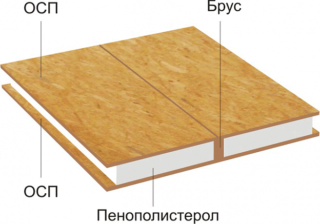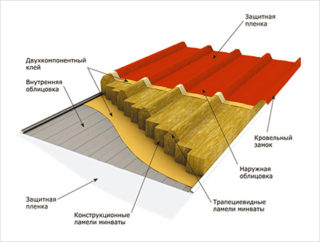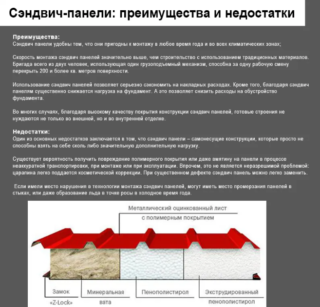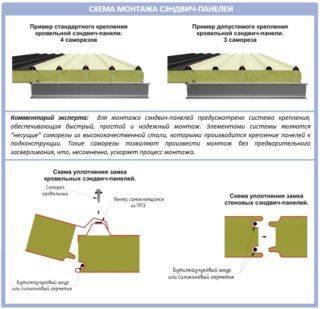The roof protects the building from precipitation and temperature changes, influences the style and design of the building, forming an idea of its owners. The innovative sandwich panel roofing is becoming more and more popular among private developers - a structure that meets all the criteria for quality and aesthetics. The material has its own characteristics, pros and cons, installation technology. Having familiarized yourself with the rules for handling it, you can easily assemble a practical and beautiful roof.
The device and structure of roofing sandwich panels
Products have the following structure:
- Front side. It is made of galvanized sheet steel, coated with polymer paint, resistant to chemicals and solar radiation. The sheet is given a protruding profile in the form of waves or trapezoid.
- Thermal insulation. Polystyrene foam, polyurethane foam or basalt wool is used. The first types of insulation are used more often, since they have greater strength and do not absorb moisture.
- Bottom layer. Also made of galvanized iron. An internal micro-profile is attached to the strip, which serves to give the board additional strength.
- Binder composition. For assembling the fragments, a special two-component polyurethane glue is used, which is characterized by high adhesion, elasticity and resistance to temperature changes.
Roofing sandwich panels have the following technical characteristics:
- length - 200-1200 cm;
- thickness - 5-30 cm;
- width - 100 cm;
- thermal conductivity - 0.020-0.044 W / m K;
- density - 40-50 kg / m²;
- the minimum estimated service life is 50 years.
When painting surfaces, a standard line of colors is used. Panels can have a single color, patterns, ornaments, including 3D.
Slabs up to 20 meters long and 2 meters wide are made to order.
Varieties of panels

During the construction process, panels that differ in size and installation technology can be used to create a roof covering.
Varieties of covering material:
- Feature assembly panels. They differ in the largest dimensions, therefore they are delivered to the object in parts. Assembly is done on site. The cassette is gradually filled with adhesive, insulation, waterproofing and an external steel strip. Some options can be painted on site, if so desired by the property owner.
- Monopanels. Versatile products that are equally practical and effective in residential and industrial construction. The lower parts of the slab are load-bearing and, after laying, act as the ceiling of the room below. Monopanels are divided into rigid and flexible models. Penoizol is placed inside - a unique material characterized by low thermal conductivity and incombustibility. The knot of abutment on soft products is performed using sealed strips. Rigid slabs are connected with a double standing seam using a seaming machine or a lock.
- Sip panels. They are monolithic boards consisting of two oriented strand board OSB-3 and expanded polystyrene between them. Fragments are joined by gluing under pressure. The result is products with high strength and excellent thermal insulation properties at low cost.A square meter of the roof can hold up to 5 tons. A variant of sip panels are blocks, where the lower part is made of OSB, and the upper part is made of profiled steel sheet.
The choice in favor of this or that material is made based on its composition, device and expected operating conditions.
Advantages and disadvantages
- Low thermal conductivity. There is no need for additional insulation. Added to this is good sound insulation.
- Quick installation due to large dimensions and quick fixing.
- Reducing the cost of the frame due to the use of a wide step between runs.
- Lightweight without significant pressure on walls and foundations.
- High strength. The roof can withstand heavy snow and wind loads without damage, and the weight of people walking on it.
- Once installed, the roof surface does not need additional finishing. The surface itself is highly aesthetic.
- The ability to dismantle for reuse at other sites.
Roof panels have several disadvantages:
- Poor tolerance to temperature changes. The metal changes its size, which leads to the occurrence of internal stresses and deformation of the coating.
- Deterioration of the filler as a result of the freezing and thawing cycles. The material gradually loses its insulating qualities.
- Natural aging of the insulation.
- UV exposure of the topcoat. The paint needs to be renewed periodically.
- Special conditions for transportation and storage. Take extra care not to bend the steel or damage the lock.
- The complexity and laboriousness of the repair. To replace one piece, you need to disassemble the entire roof.
Manufacturers do not stop working on creating more advanced materials and ways to reliably and easily connect panels to each other.
The main stages of installation
Installation of roof panels consists of the following steps:
- Preparatory. Cleaning the floor slab from debris, wires, foreign objects. Verify that the geometry of the platform is correct.
- Frame construction. It is made of shaped pipes of square or rectangular cross-section with a side of at least 40 mm. The connection of the fragments of the rafter system is carried out by welding, followed by cleaning and painting. It is advisable to make holes for self-tapping screws in advance. After that, a self-adhesive damper tape is placed on the frame.
- Laying of panels. It is carried out starting from one of the edges of the frame. Screwing is carried out manually or with a screwdriver. Fasteners have a number of features. The hardware must be held exactly at right angles to the surface. Particular attention should be paid to tightening the screws. The silicone washer should fit snugly against the metal, but not bend it.
- Fastening of panels on the sides is carried out in accordance with their designs - in a lock, rebate or sealed tape.
- If the length of one strip is not enough, a piece of the required size is cut. If this is not provided for by the design, the docking station is made independently. For this, a part of the bottom sheet and a sealant are removed from the upper strip. After that, an overlay is made, which is insulated with a sealant and fastened with self-tapping screws.
When cutting metal panels, you need to use only a hand tool or a milling cutter with a low rotation speed so as not to burn the dusting and insulation.
Modern manufacturers of roofing sandwich panels
The most popular in the construction market are products from such manufacturers:
- Asko;
- Alumin:
- Kingspan;
- Ruukki;
- Promstan;
- Keramoplast;
- Palram;
- Aluten;
- Pantek;
- PD Profil.
The products are of high quality, durability and reliability.











